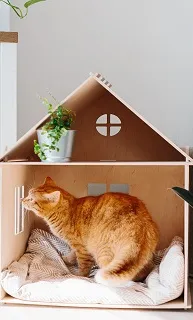Bengal Cat
Absolute athletes, Bengal Cats show that they belong to jungle as they are strong and agile cats. Despite their wild look, they are excellent family companions who just love to be around people especially children.
Average sizes and life expectancy of the breed
13-16 in
3-7 kg
12-16 years
USA
Characteristics of the Bengal Cat
The Bengal, also known as the Bengal cat, is a hybrid breed, which emerged from the crossing of domestic cats with an Asian wild cat (the so-called Asian Leopard) in South Asia. The first specimen of the Bengal breed appeared in 1963, but the breed was only officially considered in 1985. Considered a docile companion generally, Bengal cat is also very strong and athletic. The pattern of its fur resembles that of a leopard, making it a very beautiful and exotic cat.

Coat
The Bengal's coat is short, soft and silky and their pattern resembles a leopard's fur. Usually its colors are brown, ice and marble, and may also be mixed, which gives them a wilder look. The most popular coat style of Bengal Cat is the spotted one. In this coat style, the skin covered in random, diagonally or horizontally aligned spots on the torso, tummy and legs just like you see it on Leopards. When it comes to shedding, Bengal cats are among the least shedders albeit they do shed. In order to reduce shedding and to maintain the luster of their skin, you will have to brush them regularly with a fine quality slicker brush. Also, whenever you are taking them for a bath, make sure you thoroughly brush them so that all kinds of minor mats and tangles are removed from the coat. You may also consider rinsing them with a high quality shampoo to bolster the sheen of their coat.
Pet Profile
Best Cat Food For Bengal Cats
Like majority of the cats, Bengal Cats too require a diet rich in protein mainly coming from meat. They are among those cats who simply relish meat like Chicken, Beef, Lamb and Fish. Also, it is not recommended to feed them plant based foods as Bengal Cats are not entirely fine-tuned to synthesise veg based foods. Another reason for not feeding veg foods to your cats is that plants don't have vital amino acid and Taurine which is absolutely necessary for the cats. You may feed wet cat foods to the Bengal cats, provided that it consists of atleast 65% moisture content. This would help your cats to stay hydrated all the time. Also, there are certain ingredients which you should absolutely refrain from giving it to your cats. The items include corn, soy, wheat and oats etc, which can trigger allergic reaction in the Bengal Cats. You should also not feed adult Bengal cats milk as unlike other cats, this breed can develop lactose intolerance.
Grooming Your Bengal Cats
Bengal Cat's grooming requirements are much less compared to other cats as they have thin hair and coat. In spite of this, they can experience a bit of shedding especially in the season of autumn. To keep their hair fall to nil, consider brushing their hair with a fine quality slicker brush once every week. When it comes to bathing, Bengal cats only need to be bathed once in every 2-3 months. But before bathing, just ensure that you comb their hair so that you can effectively remove mats and tangles. Using a good quality shampoo would be ideal for repelling ticks and fleas from infesting into your cat's skin. Once you have rinsed of all the shampoo from their skin, you can use a dry, soft cotton ball to clean them off.
Taking Care of a Bengal Cat
Being an athletic and curious cat, you have to be careful with this cat's attempts to climb trees and climb surfaces. To deal with their high energy, it would be best if you can give them some interactive toys that will keep them engaged for a long time. Unlike other domestic cats, Bengal Cats have this great love for water and will readily jump along with you in a pool. If you have aquarium inside your house, you have to be vigilant otherwise this cat can turn it into a fishing pond. Although Bengal cats get along with other felines and dogs, they are not the best companions of smaller pets like rabbits and rodents. These two are Bengal cat's natural prey and hence they are not suitable for being raised alongside this cat.
History of Bengal Cats
Bengal Cat came into existence when ancient breeders crossed Egyptian Maus with Asian Leopard Cats. The main aim of the breeders was to create a domestic cat with a coat like a wild cat. In fact, it is Bengal Cat's wild-looking skin itself that makes them one of the stylish looking cats that exist today. In 1983, Bengal Cats were first recognised as experimental breed by TICA and they received their full recognition in 1993. As of today, Bengal cats are only bred from other Bengals and consequently, they have been several generations removed from their exotic ancestors.